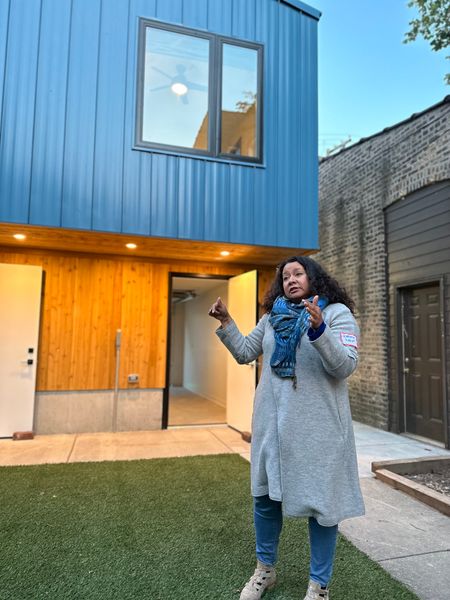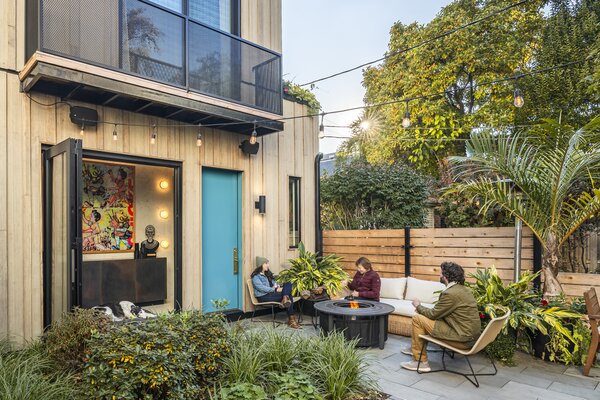Thousands more homeowners will ultimately have the option to build the units on their properties.
In a highly anticipated vote on Thursday, Chicago’s city council unanimously approved an ordinance to legalize the construction of accessory dwelling units, or ADUs, across more of the city. The ordinance expands on a pilot program that took effect May of 2021 that allows ADUs in the form of coach houses and basement units in five small pilot areas. Now, units are allowed in all multifamily zoning districts (except for ones downtown) in addition to the single-family zoning districts that are inside the extant pilot areas, increasing the eligible area to build by about 135 percent.
Alderpeople, however, will still have final say as to whether the units can be built in their wards. Additionally, property owners wanting to build basement units, coach houses, or attic dwellings must hire contractors who participate in registered apprenticeship programs, a rule that doesn’t apply to any other type of housing in Chicago. This will make it more expensive to build an ADU and harder to find a qualified contractor who can provide a competitive bid. (A list on the U.S. Department of Labor’s website shows 24 qualifying employers in Chicago, out of thousands of licensed companies in the city.)

Latent Design founder and principal, Katherine Darnstadt, built a new coach house in Lakeview for a client expecting their first child and who plans to have their parent move in to help with childcare.
Courtesy of Latent Design
Such a requirement would also make it much harder for new builders, including graduates of apprenticeship programs, to break into smaller-scale construction. The programs are less diverse, too, than the state’s construction industry at large, a concern of one alderperson I spoke with.
Thursday’s vote is a compromise of two opposing ordinances that would have had disparate results in adding housing to the city: the original, introduced by Ward Alderperson Lawson in May of 2023, proposed allowing ADUs in all zoning districts that allowed housing in Chicago, except for ones downtown, comprising 61 percent of the the city. This would have offered the greatest opportunity for homeowners to obtain permits to build units, whether to accommodate extended family members or new tenants.
In contrast, an alternative proposal from 13th Ward Alderperson Quinn would have allowed ADUs in fewer zoning districts, comprising only 20 percent of the city. According to Quinn, ADUs "compromise the integrity of single-family dwellings in neighborhoods by turning raised ranches or bungalows into apartment buildings overnight with no aldermanic oversight or no community input," he told Southwest Regional Publishing. His ordinance would have created a convoluted system of geographies wherein specific areas have a unique set of rules, creating havoc for homeowners and consulting architects who would be trying to determine what kind of ADU they can build and where.

Beth Malloy and her son, Zach, and daughter-in-law, Beth Anderson, built one of the first additional dwelling units in Chicago since the city began allowing them again in 2021. They pooled their resources to purchase a home and built a coach house at the rear.
Photo: Yeva Dashevsky
In 1957, Chicago introduced zoning ordinances that put an end to most ADU construction. New parking requirements for residential units allocated space for cars, not additional living space. Arguments were also made—and won—for preserving neighborhood character, and mitigating overcrowding in the city.
Today, Chicago is short more than 100,000 housing units, and a confluence of factors including zoning restrictions and higher borrowing and construction costs have put the city on track to permit 15 to 30 percent fewer homes this year than last. This kind of slow down is thought to increase the cost of housing, which bears out in recent apartment market data from Redfin showing Chicago had the highest year-over-year increase in average rents compared with other major metropolitan areas in the U.S.
Since the city started the pilot program in 2021, however, people have been building. More than 430 units in over 370 buildings have been permitted in the five small pilot areas. While the number of ADUs being built now might not be making the city more affordable, a dramatic increase could potentially shift rent prices in the right direction. ADUs also give homeowners a way to house family members or earn additional income through renting. (Surveys of ADU owners in Seattle and Portland, Oregon, show that units are rented at slightly lower prices than apartments in the same neighborhood, and up to a quarter of them are rented for free to family and friends.)
When the ordinance goes into effect on April 1, 2026, more work will be needed to make resources to build ADUs more widely available and add the "gentle density" the ordinance is designed to create. The renewal of an expired ADU funding program to design and build units would help convert unpermitted basement and attic apartments. Multilingual design and permitting resources and clarity and consistency in the permit review process could also accelerate ADU construction across neighborhoods.
Making it easier to build ADUs in more parts of the city is a step toward addressing Chicago’s twin threats of rising housing costs and unmet demand for new homes, but it is now largely up to alderpeople to facilitate construction in their areas.
Related Reading:
ADUs Were Banned in Chicago for Almost 70 Years. This Woman Just Built One of the First
ADUs Might Not Be Making Chicago More Affordable, But They Might Make It More Sustainable
Read More
By: Steven Vance
Title: Chicago Just Agreed to Allow More ADUs—With Some Caveats
Sourced From: www.dwell.com/article/chicago-adu-vote-granny-flat-proposal-affordable-housing-127ceeac
Published Date: Fri, 26 Sep 2025 14:57:44 GMT
Did you miss our previous article...
https://trendinginbusiness.business/real-estate/a-dinner-at-noma-inspired-this-upstate-new-york-retreat
.png)





